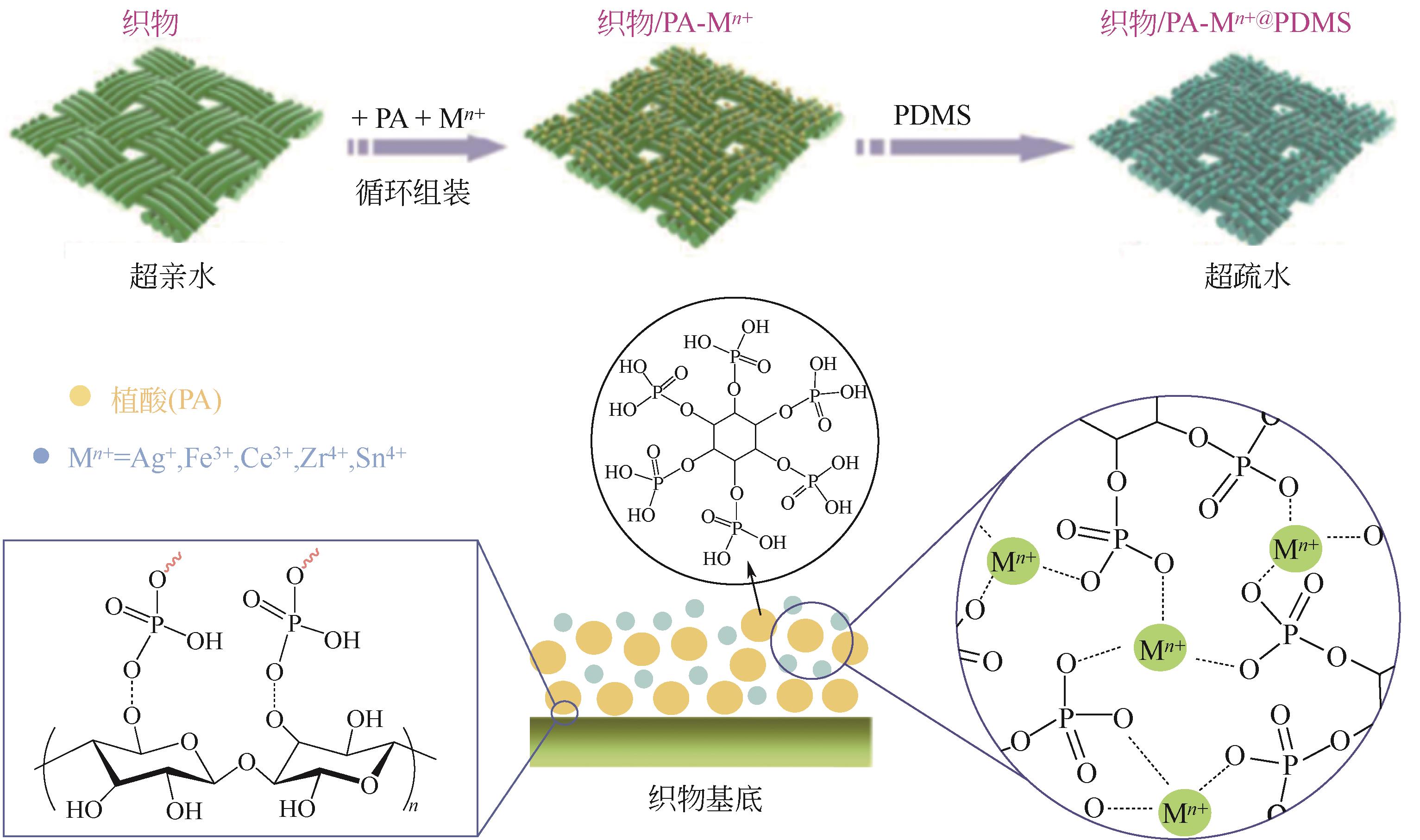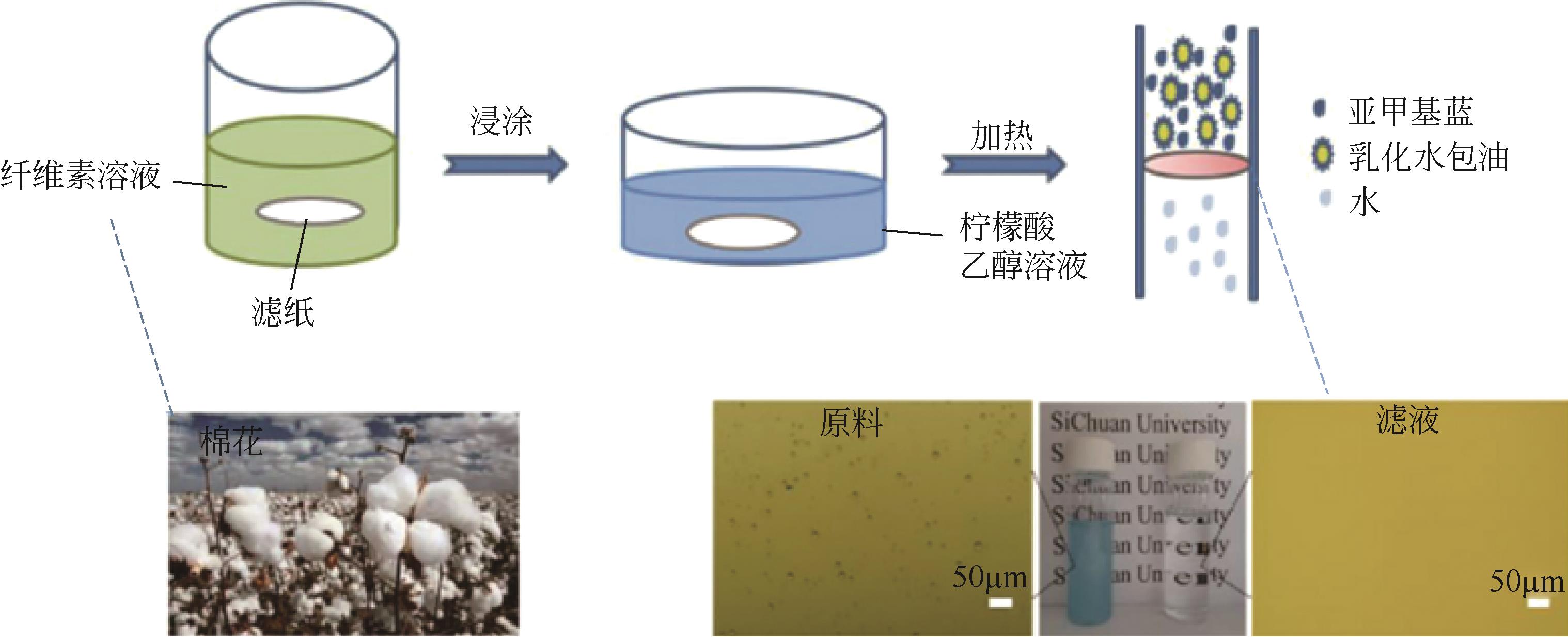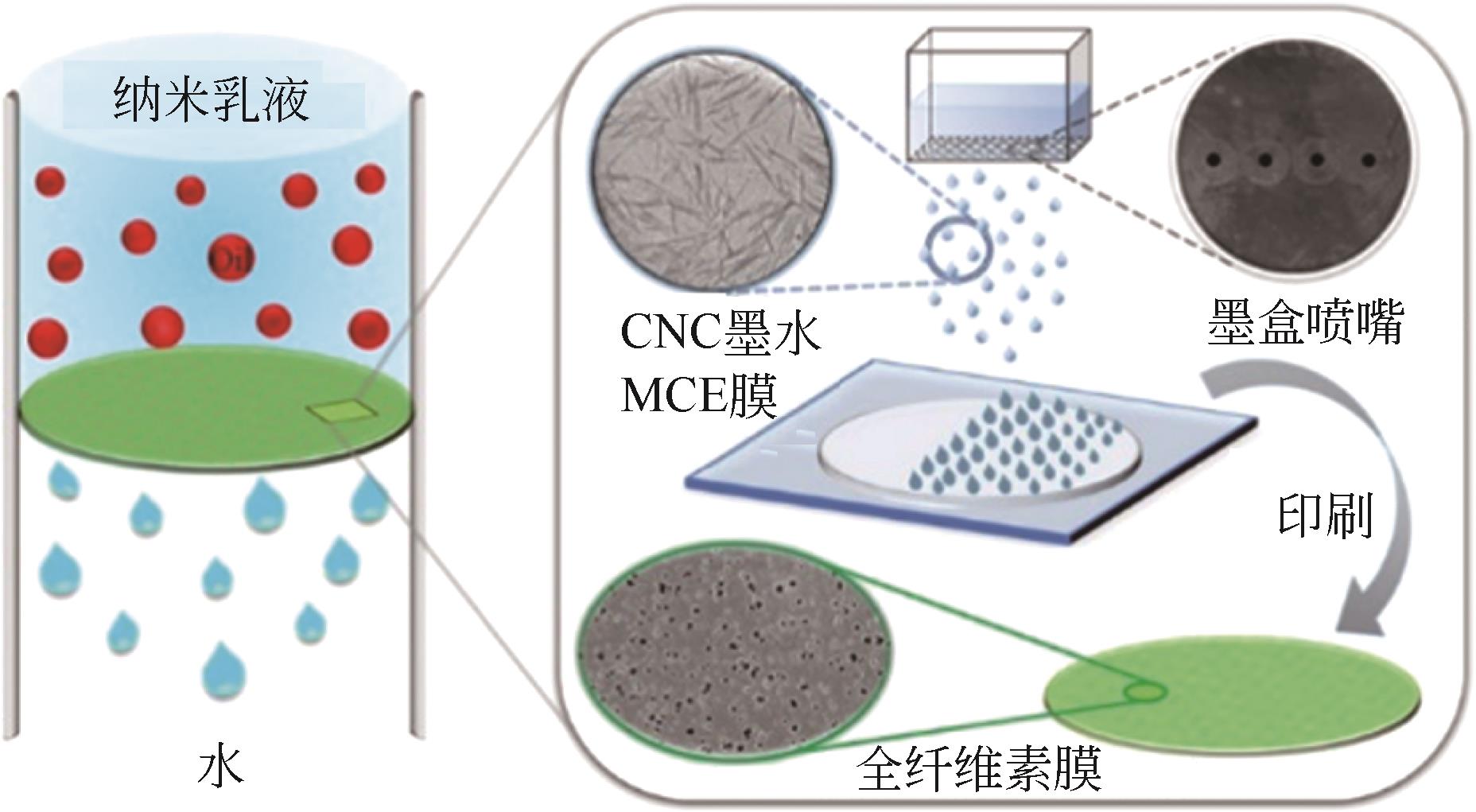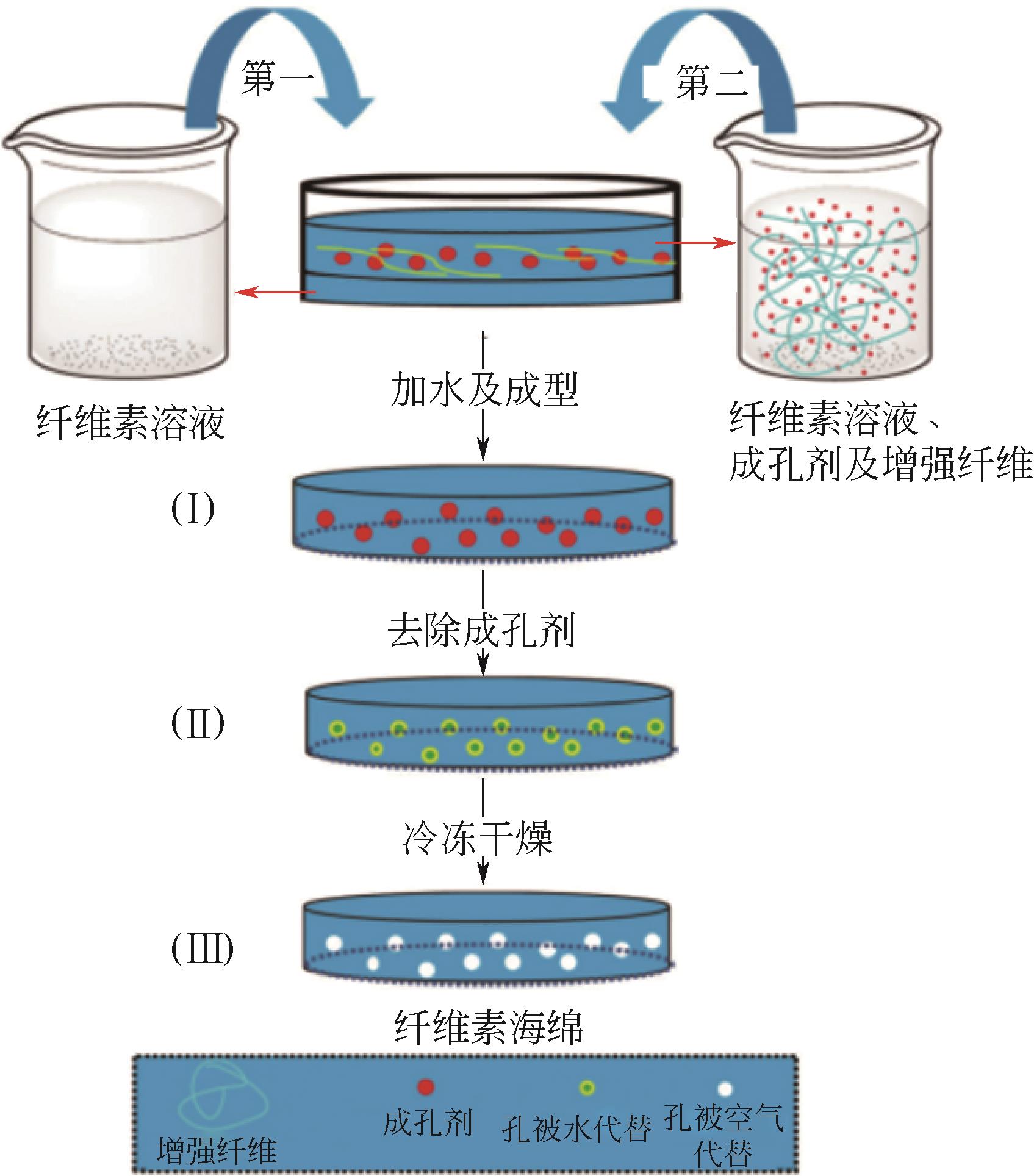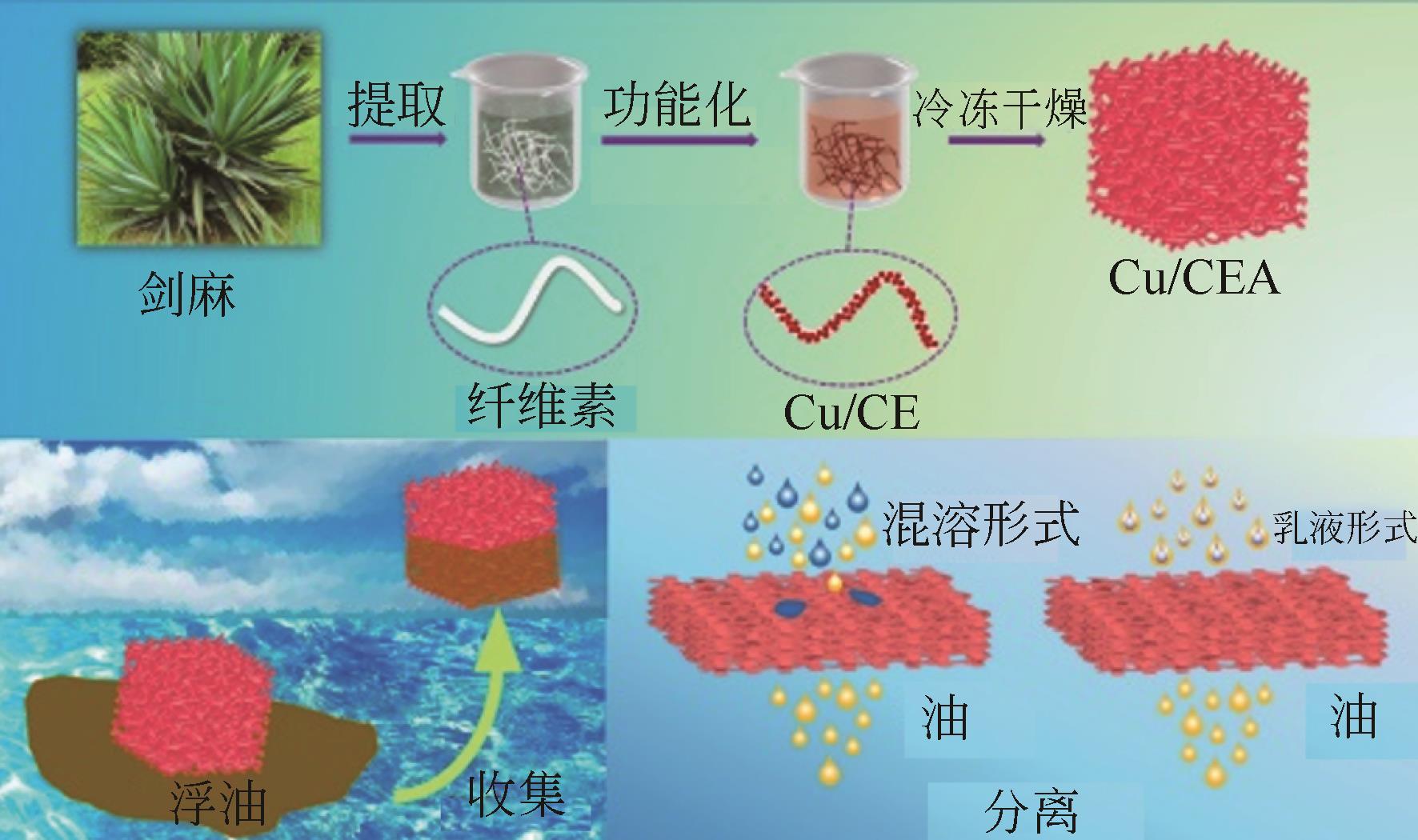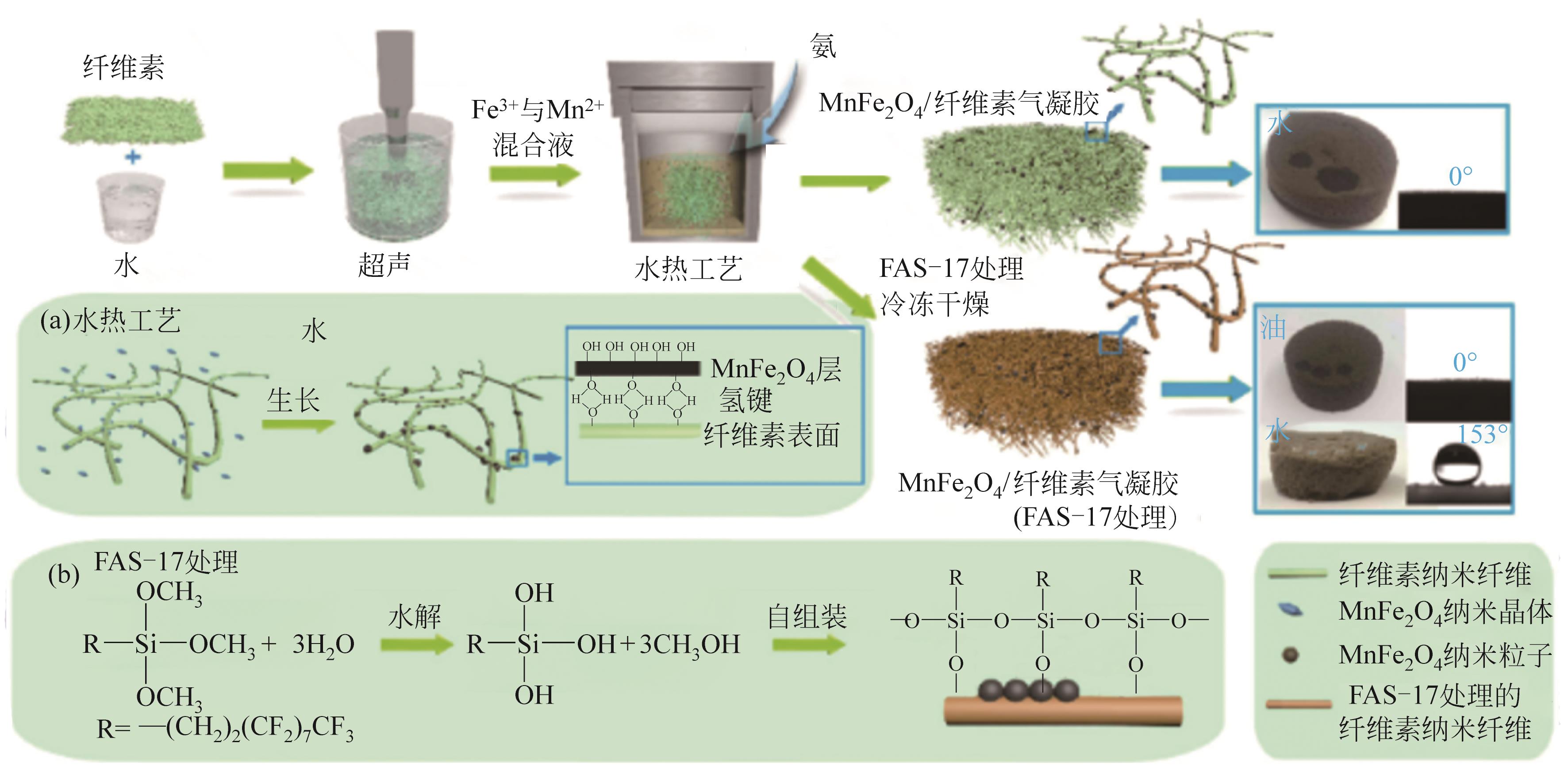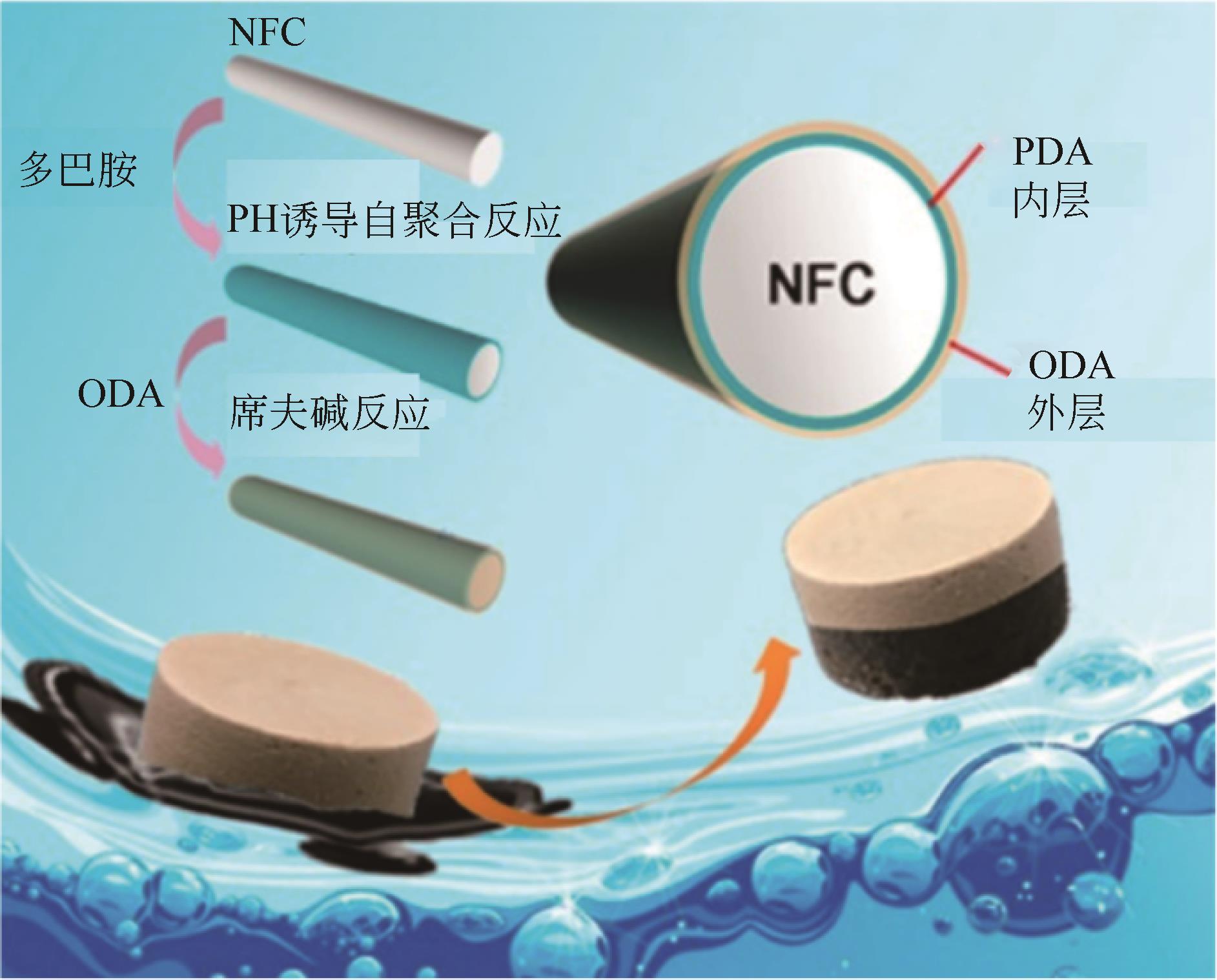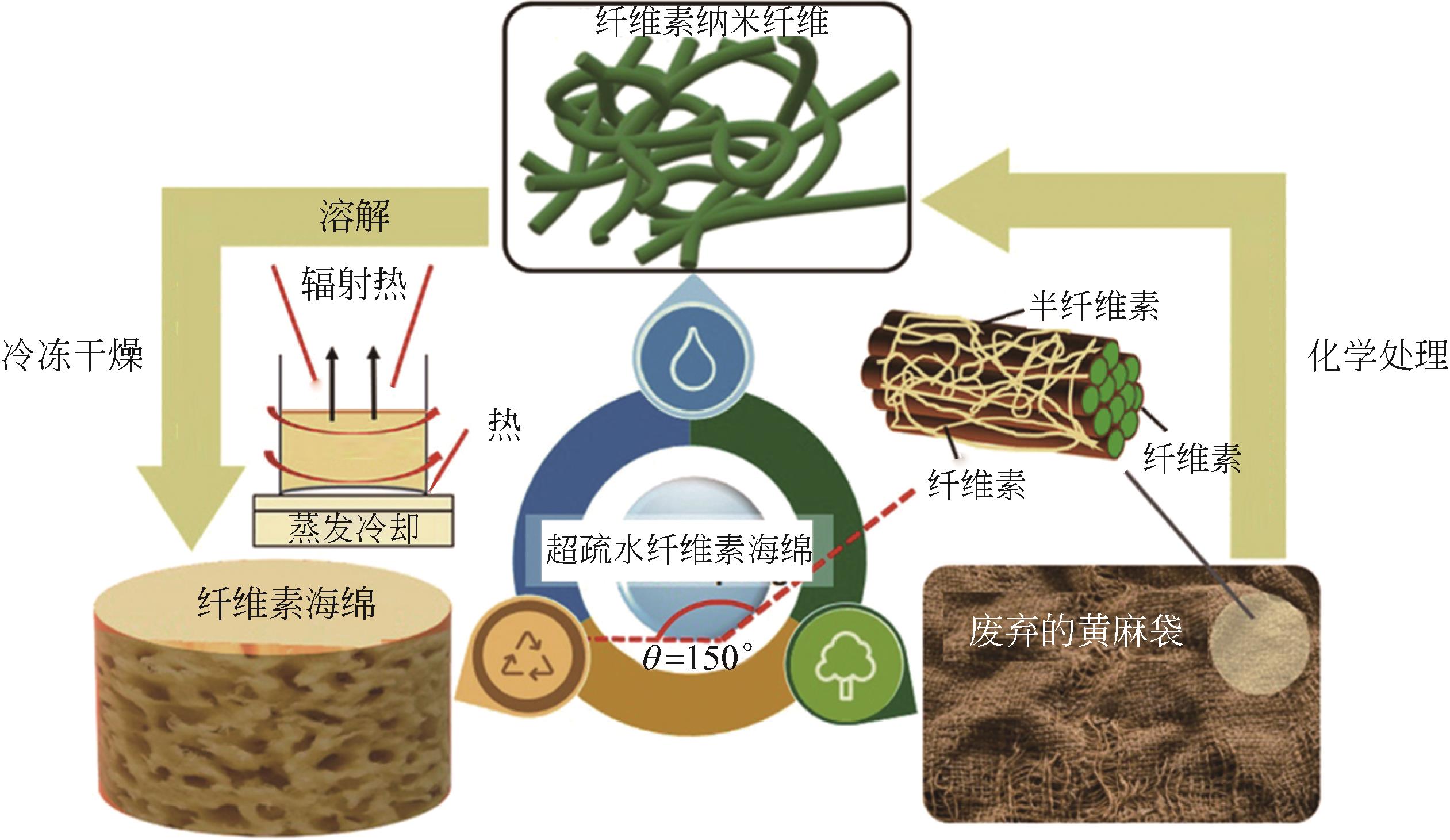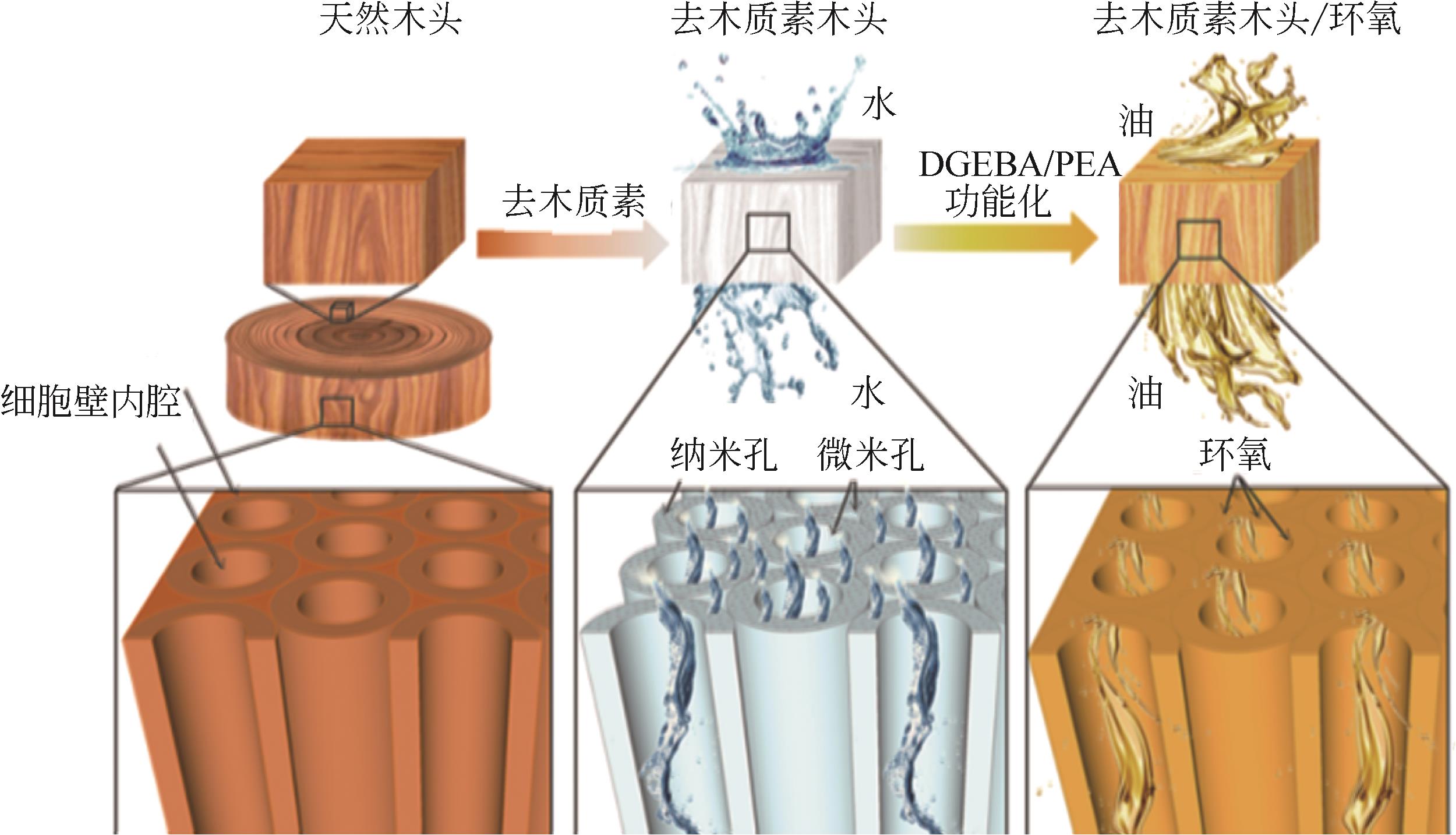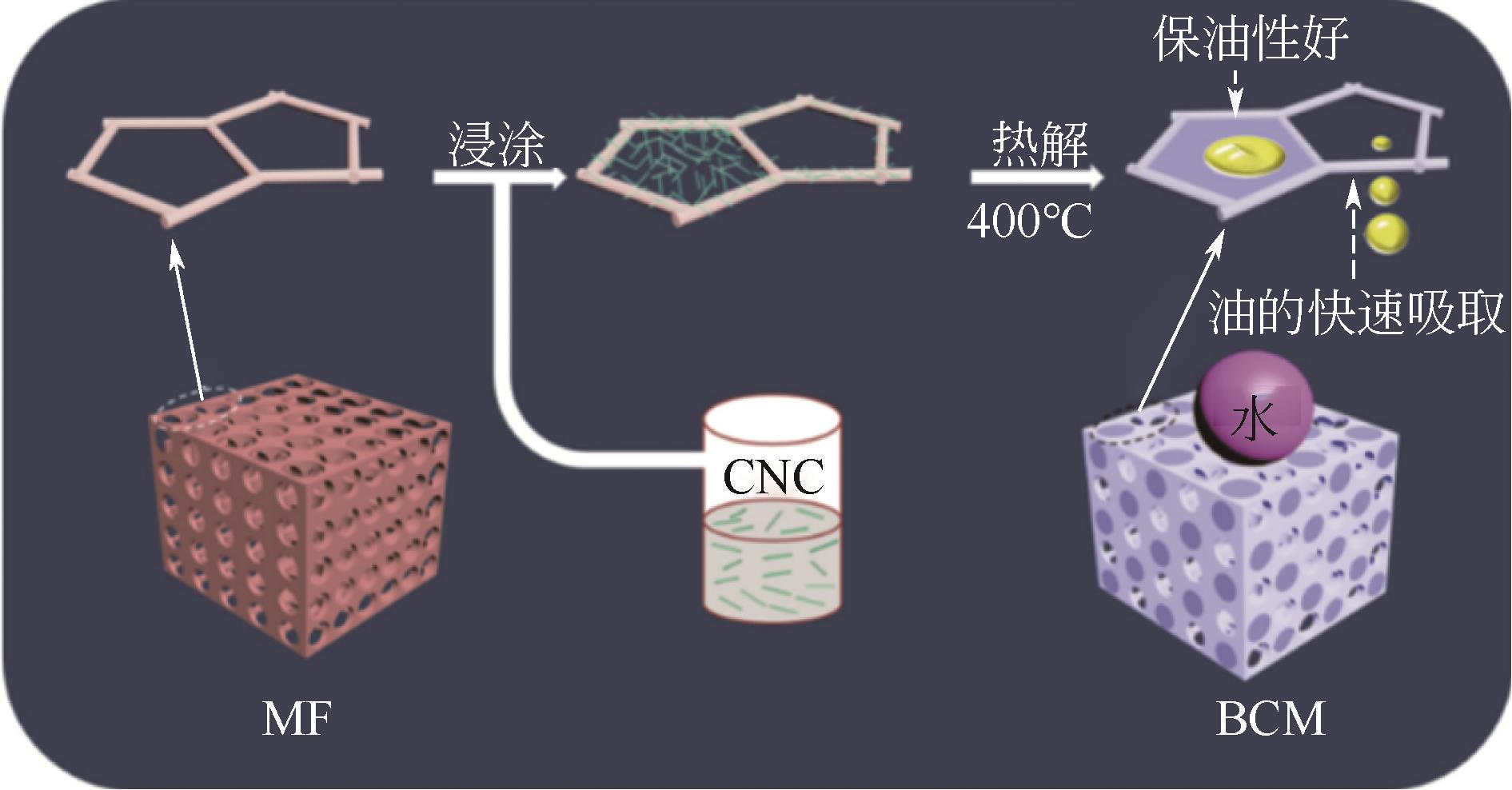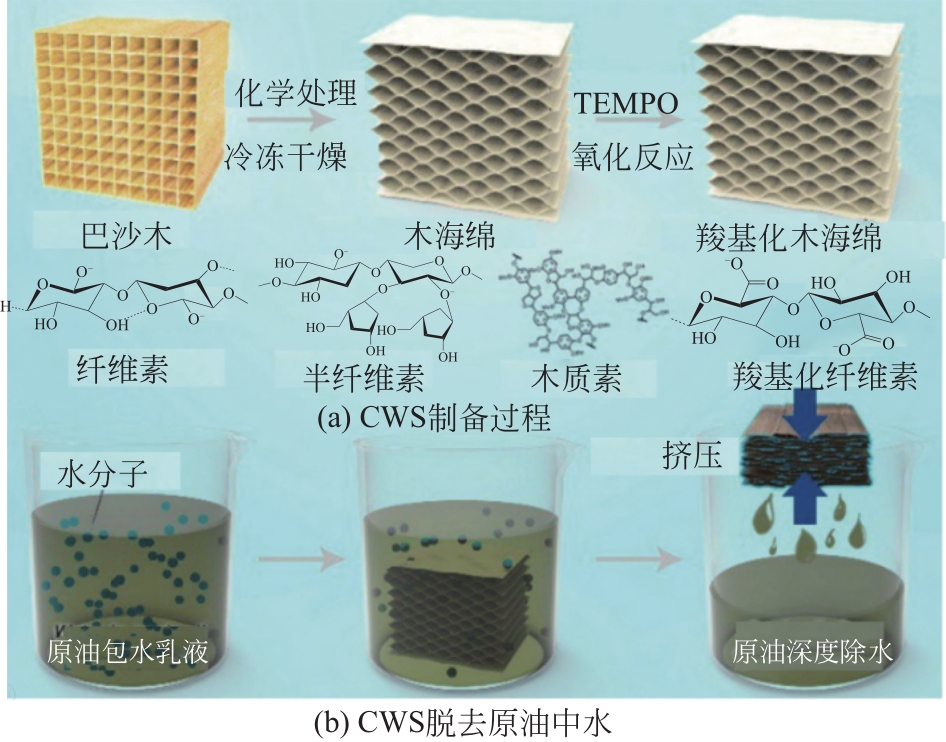化工进展 ›› 2022, Vol. 41 ›› Issue (6): 3038-3050.DOI: 10.16085/j.issn.1000-6613.2021-1429
纤维素基油水分离材料研究进展
- 中山大学化学工程与技术学院,广东 珠海 519000
-
收稿日期:2021-07-06修回日期:2021-08-06出版日期:2022-06-10发布日期:2022-06-21 -
通讯作者:顾林 -
作者简介:叶泽权(1997—),男,硕士研究生,研究方向为纤维素基油水分离材料。E-mail:yezequan@163.com 。 -
基金资助:国家自然科学基金(51973231);广东省自然科学基金(2021A1515012449);中山大学中央高校基本科研业务费专项(20lgzd17)
Recent progress in cellulose-based materials for oil-water separation
YE Zequan( ), WU Qingyun, GU Lin(
), WU Qingyun, GU Lin( )
)
- School of Chemical Engineering and Technology, Sun Yat-Sen University, Zhuhai 519000, Guangdong, China
-
Received:2021-07-06Revised:2021-08-06Online:2022-06-10Published:2022-06-21 -
Contact:GU Lin
摘要:
石油泄漏事故及工业含油废水排放等严重破坏了人类赖以生存的生态环境,如何有效分离油水混合物成了当前的研究热点。传统的油水分离材料的不可回收性带来材料的二次污染极大限制了它们的广泛应用。纤维素是地球上最丰富的天然聚合物,并且具有生物相容性、生物降解性、化学稳定性和低成本等特点,因此纤维素基油水分离材料亦受到广泛关注。本文系统总结了近年来过滤型和吸附型纤维素基油水分离材料的研究进展,重点围绕纤维素类物质作材料基底(滤纸、棉布等)、用其进行表面改性(纤维素纳米晶体、纤维素衍生物等)以及全纤维素基油水分离材料等方面进行详细分析和介绍,对纤维素基油水分离材料存在的问题进行了探讨,并对其未来发展进行了展望。
中图分类号:
引用本文
叶泽权, 吴青芸, 顾林. 纤维素基油水分离材料研究进展[J]. 化工进展, 2022, 41(6): 3038-3050.
YE Zequan, WU Qingyun, GU Lin. Recent progress in cellulose-based materials for oil-water separation[J]. Chemical Industry and Engineering Progress, 2022, 41(6): 3038-3050.
| 基底 | 表面改性物质 | 方法 | 油水分离形式 | 分离 效率/% | 流量 /L·m-2·h-1 | 参考文献 |
|---|---|---|---|---|---|---|
| 纤维素滤纸 | 聚乙烯醇与戊二醛的交联 | 浸涂法 | 水包己烷乳液 | >99.9 | 60 | [ |
| 纤维素滤纸 | 锌铝层状双氢氧化物纳米片、硅烷偶联剂 | 原位生长法、接枝法 | 水包甲苯乳液 | >94.4 | 500 | [ |
| 纤维素织物 | 二氧化钛溶胶、含氟聚合物 | 浸涂法 | 二氯甲烷/水混合物 | 99.5 | 未提及 | [ |
| 纤维素织物 | 微孔聚合物、氟化烷基硅氧烷 | 浸涂法 | 十六烷/水混合物 | 99.96 | 未提及 | [ |
| 纤维素织物 | 硼酸-二氧化硅-烷基-硅烷涂层 | 浸干法 | 氯仿-水混合物 | 约100 | 未提及 | [ |
| 纤维素织物 | 大豆油、氧化锌 、硬脂酸 | 两步固化浸涂法 | 癸烷/水混合物 | 97~99 | 23500~33800 | [ |
| 纤维素织物 | 大豆油、硬脂酸 | 酶蚀刻法、表面涂层法 | 氯仿/水混合物 | 98 | 43600~61100 | [ |
| 纤维素织物 | 聚二甲基硅氧烷/植酸金属络合物 | 循环组装法、浸渍固化法 | 氯仿/水混合物 | 99.5 | 未提及 | [ |
| 纤维素织物 | 片状六方氧化锌、月桂酸 | 原位合成法和浸涂法 | 油/水混合物 | >96.5 | 2900~3400 | [ |
| 纤维素膜 | 聚{[3-(三甲氧基甲硅烷基)丙酯]-嵌段月桂烯} | 接枝法 | 含有无机/有机颗粒的原油/水混合物 | 未提及 | 约1000 | [ |
| 银/CNF复合纸 | 银 | 交替过滤法 | 水包二甲苯乳液 | >96 | 约140 | [ |
| 桉木浆纤维素纸 | 丙烯酸/丙烯酰胺 | 接枝法 | 油/水混合物 | >97.6 | 未提及 | [ |
| 纤维素纳米纤维膜 | 氧化石墨烯 | 静电纺丝技术 | 正己烷/水混合物 | >97.3 | 960 | [ |
表1 以纤维素类物质作基底的过滤型油水分离材料
| 基底 | 表面改性物质 | 方法 | 油水分离形式 | 分离 效率/% | 流量 /L·m-2·h-1 | 参考文献 |
|---|---|---|---|---|---|---|
| 纤维素滤纸 | 聚乙烯醇与戊二醛的交联 | 浸涂法 | 水包己烷乳液 | >99.9 | 60 | [ |
| 纤维素滤纸 | 锌铝层状双氢氧化物纳米片、硅烷偶联剂 | 原位生长法、接枝法 | 水包甲苯乳液 | >94.4 | 500 | [ |
| 纤维素织物 | 二氧化钛溶胶、含氟聚合物 | 浸涂法 | 二氯甲烷/水混合物 | 99.5 | 未提及 | [ |
| 纤维素织物 | 微孔聚合物、氟化烷基硅氧烷 | 浸涂法 | 十六烷/水混合物 | 99.96 | 未提及 | [ |
| 纤维素织物 | 硼酸-二氧化硅-烷基-硅烷涂层 | 浸干法 | 氯仿-水混合物 | 约100 | 未提及 | [ |
| 纤维素织物 | 大豆油、氧化锌 、硬脂酸 | 两步固化浸涂法 | 癸烷/水混合物 | 97~99 | 23500~33800 | [ |
| 纤维素织物 | 大豆油、硬脂酸 | 酶蚀刻法、表面涂层法 | 氯仿/水混合物 | 98 | 43600~61100 | [ |
| 纤维素织物 | 聚二甲基硅氧烷/植酸金属络合物 | 循环组装法、浸渍固化法 | 氯仿/水混合物 | 99.5 | 未提及 | [ |
| 纤维素织物 | 片状六方氧化锌、月桂酸 | 原位合成法和浸涂法 | 油/水混合物 | >96.5 | 2900~3400 | [ |
| 纤维素膜 | 聚{[3-(三甲氧基甲硅烷基)丙酯]-嵌段月桂烯} | 接枝法 | 含有无机/有机颗粒的原油/水混合物 | 未提及 | 约1000 | [ |
| 银/CNF复合纸 | 银 | 交替过滤法 | 水包二甲苯乳液 | >96 | 约140 | [ |
| 桉木浆纤维素纸 | 丙烯酸/丙烯酰胺 | 接枝法 | 油/水混合物 | >97.6 | 未提及 | [ |
| 纤维素纳米纤维膜 | 氧化石墨烯 | 静电纺丝技术 | 正己烷/水混合物 | >97.3 | 960 | [ |
| 基底 | 表面改性物质 | 方法 | 油水分离形式 | 分离效率 /% | 流量 /L·m-2·h-1 | 参考 文献 |
|---|---|---|---|---|---|---|
| 铜网 | 纤维素纳米晶体 | 层层自组装法 | 原油/水混合物 | 约99.6 | 35000 | [ |
| 尼龙滤纸 | 被囊状纤维素纳米晶体 | 真空辅助过滤法 | 异辛烷水纳米乳液 | 约100 | >1700 | [ |
| 金属网 | 柠檬酸交联纤维素水凝胶 | 浸涂法 | 正己烷/水混合物 | >98.9 | 12885 | [ |
| 金属网 | 羧甲基纤维素 | 浸渍法、喷涂法 | 环己烷/水混合物 | >99.5 | 2400 | [ |
| 纤维素滤纸 | 与柠檬酸交联的纤维素凝胶 | 浸涂法 | 水包甲苯乳液 | 95.9 | 约24 | [ |
| 纤维素滤纸 | 被囊类纤维素纳米晶体,环氧氯丙烷 | 过滤及交联反应 | 正己烷/水混合物 | >97.9 | 约300L·m-2·h-1·bar-1 | [ |
| 纤维素织物 | 纤维素 | 纤维素溶解和再生法 | 水包甲苯乳液 | >93.2 | >4000 | [ |
| 醋酸纤维素纳米纤维膜 | 静电纺丝法、脱乙酰法 | 氯仿/水混合物 | 99.97 | 38000 | [ | |
| 纤维素酯 | 纤维素纳米晶体 | 增材印刷策略 | 水包正己烷乳液 | >99 | >1500L·m-2·h-1·bar-1 | [ |
| 醋酸纤维素 | 墨水书写技术 | 油/水混合物 | >95 | 160000 | [ | |
| 纤维素海绵 | 冷冻干燥法 | 水包油乳液 | >99.94 | 91 | [ | |
| 纤维素海绵 | 冷冻干燥法 | 水包油乳液 | 99.2 | 142~290 | [ | |
| 纤维素纳米纤维气凝胶 | 高碘酸钠、亚硫酸钠 | 磺化法 | 煤油水混合物 | 99.33 | 360 | [ |
表2 以纤维素类物质作表面及全纤维素的过滤型油水分离材料
| 基底 | 表面改性物质 | 方法 | 油水分离形式 | 分离效率 /% | 流量 /L·m-2·h-1 | 参考 文献 |
|---|---|---|---|---|---|---|
| 铜网 | 纤维素纳米晶体 | 层层自组装法 | 原油/水混合物 | 约99.6 | 35000 | [ |
| 尼龙滤纸 | 被囊状纤维素纳米晶体 | 真空辅助过滤法 | 异辛烷水纳米乳液 | 约100 | >1700 | [ |
| 金属网 | 柠檬酸交联纤维素水凝胶 | 浸涂法 | 正己烷/水混合物 | >98.9 | 12885 | [ |
| 金属网 | 羧甲基纤维素 | 浸渍法、喷涂法 | 环己烷/水混合物 | >99.5 | 2400 | [ |
| 纤维素滤纸 | 与柠檬酸交联的纤维素凝胶 | 浸涂法 | 水包甲苯乳液 | 95.9 | 约24 | [ |
| 纤维素滤纸 | 被囊类纤维素纳米晶体,环氧氯丙烷 | 过滤及交联反应 | 正己烷/水混合物 | >97.9 | 约300L·m-2·h-1·bar-1 | [ |
| 纤维素织物 | 纤维素 | 纤维素溶解和再生法 | 水包甲苯乳液 | >93.2 | >4000 | [ |
| 醋酸纤维素纳米纤维膜 | 静电纺丝法、脱乙酰法 | 氯仿/水混合物 | 99.97 | 38000 | [ | |
| 纤维素酯 | 纤维素纳米晶体 | 增材印刷策略 | 水包正己烷乳液 | >99 | >1500L·m-2·h-1·bar-1 | [ |
| 醋酸纤维素 | 墨水书写技术 | 油/水混合物 | >95 | 160000 | [ | |
| 纤维素海绵 | 冷冻干燥法 | 水包油乳液 | >99.94 | 91 | [ | |
| 纤维素海绵 | 冷冻干燥法 | 水包油乳液 | 99.2 | 142~290 | [ | |
| 纤维素纳米纤维气凝胶 | 高碘酸钠、亚硫酸钠 | 磺化法 | 煤油水混合物 | 99.33 | 360 | [ |
| 基底 | 表面改性物质 | 方法 | 吸附类型 | 吸附能力/g·g-1 | 参考文献 |
|---|---|---|---|---|---|
| 微纤化纤维素气凝胶 | 甲基三乙氧基硅烷 | 硅烷化反应 | 氯仿 | 159 | [ |
| 纤维素气凝胶 | 铜纳米粒子 | 一步入金 | 氯仿 | 164.5 | [ |
| 纤维素气凝胶 | 超细锰氟烷基硅烷 | 水热法、浸涂法 | 机油 | 112 | [ |
| 纳米晶纤维素水凝胶 | 三聚氯氰、氯丙基三乙氧基硅烷 | 冷冻干燥法 | 十二烷 | 16 | [ |
| 纤维素气凝胶 | 聚多巴胺/十八胺 | pH诱导自聚合、席夫碱反应 | 氯仿 | 176 | [ |
| 纤维素海绵 | 原硅酸四乙酯/十六烷基三甲氧基硅烷 | 溶胶-凝胶法、冷冻干燥法 | 柴油 | 35.55 | [ |
| 乙基纤维素海绵 | 硅烷化碳纳米管、纳米二氧化硅、十六烷基三甲氧基硅烷 | 涂层法 | 石油醚 | 约100 | [ |
| 纤维素海绵 | 烷基胺 | 接枝法 | 四氯化碳 | 80 | [ |
| 纤维素海绵 | 聚苯并 嗪/还原氧化石墨烯 嗪/还原氧化石墨烯 | 浸涂法 | 氯仿 | 123 | [ |
| 棉纤维 | 三氯烷基硅烷 | 接枝法 | 油 | 18 | [ |
| 去木质素海绵 | 甲基三甲氧基硅烷 | 接枝法 | 氯仿 | 41 | [ |
| 脱木质素木头 | 反应性环氧-胺体系 | 真空辅助溶液灌注法 | 二氯甲烷 | 15 | [ |
| 脱木质素木头 | 十六烷基三甲氧基硅烷 | 接枝法 | 硅油 | 37 | [ |
| 三聚氰胺海绵 | 纤维素纳米晶体 | 浸渍-吸附-热解法 | 油 | 201 | [ |
| 天然棉纤维 | 炭化法 | 花生油 | 60 | [ | |
| 纤维素纤维 | 乙酸酐 | 乙酰化法 | 原油 | 67.54 | [ |
| 脱木质素木头 | 2,2,6,6-四甲基哌啶氧化物 | 氧化法 | 水 | 99.99%(除水率) | [ |
表3 吸附型纤维素基油水分离材料
| 基底 | 表面改性物质 | 方法 | 吸附类型 | 吸附能力/g·g-1 | 参考文献 |
|---|---|---|---|---|---|
| 微纤化纤维素气凝胶 | 甲基三乙氧基硅烷 | 硅烷化反应 | 氯仿 | 159 | [ |
| 纤维素气凝胶 | 铜纳米粒子 | 一步入金 | 氯仿 | 164.5 | [ |
| 纤维素气凝胶 | 超细锰氟烷基硅烷 | 水热法、浸涂法 | 机油 | 112 | [ |
| 纳米晶纤维素水凝胶 | 三聚氯氰、氯丙基三乙氧基硅烷 | 冷冻干燥法 | 十二烷 | 16 | [ |
| 纤维素气凝胶 | 聚多巴胺/十八胺 | pH诱导自聚合、席夫碱反应 | 氯仿 | 176 | [ |
| 纤维素海绵 | 原硅酸四乙酯/十六烷基三甲氧基硅烷 | 溶胶-凝胶法、冷冻干燥法 | 柴油 | 35.55 | [ |
| 乙基纤维素海绵 | 硅烷化碳纳米管、纳米二氧化硅、十六烷基三甲氧基硅烷 | 涂层法 | 石油醚 | 约100 | [ |
| 纤维素海绵 | 烷基胺 | 接枝法 | 四氯化碳 | 80 | [ |
| 纤维素海绵 | 聚苯并 嗪/还原氧化石墨烯 嗪/还原氧化石墨烯 | 浸涂法 | 氯仿 | 123 | [ |
| 棉纤维 | 三氯烷基硅烷 | 接枝法 | 油 | 18 | [ |
| 去木质素海绵 | 甲基三甲氧基硅烷 | 接枝法 | 氯仿 | 41 | [ |
| 脱木质素木头 | 反应性环氧-胺体系 | 真空辅助溶液灌注法 | 二氯甲烷 | 15 | [ |
| 脱木质素木头 | 十六烷基三甲氧基硅烷 | 接枝法 | 硅油 | 37 | [ |
| 三聚氰胺海绵 | 纤维素纳米晶体 | 浸渍-吸附-热解法 | 油 | 201 | [ |
| 天然棉纤维 | 炭化法 | 花生油 | 60 | [ | |
| 纤维素纤维 | 乙酸酐 | 乙酰化法 | 原油 | 67.54 | [ |
| 脱木质素木头 | 2,2,6,6-四甲基哌啶氧化物 | 氧化法 | 水 | 99.99%(除水率) | [ |
| 1 | BENGANI-LUTZ P, ZAF R D, CULFAZ-EMECEN P Z, et al. Extremely fouling resistant zwitterionic copolymer membranes with ~ 1nm pore size for treating municipal, oily and textile wastewater streams[J]. Journal of Membrane Science, 2017, 543: 184-194. |
| 2 | CHENG Y C, LI X F, XU Q, et al. SAR observation and model tracking of an oil spill event in coastal waters[J]. Marine Pollution Bulletin, 2011, 62(2): 350-363. |
| 3 | DOSHI B, SILLANPÄÄ M, KALLIOLA S. A review of bio-based materials for oil spill treatment[J]. Water Research, 2018, 135: 262-277. |
| 4 | CHEN C L, WENG D, MAHMOOD A, et al. Separation mechanism and construction of surfaces with special wettability for oil/water separation[J]. ACS Applied Materials & Interfaces, 2019, 11(11): 11006-11027. |
| 5 | DOSHI B, REPO E, HEISKANEN J P, et al. Sodium salt of oleoyl carboxymethyl chitosan: a sustainable adsorbent in the oil spill treatment[J]. Journal of Cleaner Production, 2018, 170: 339-350. |
| 6 | VENTIKOS N. A high-level synthesis of oil spill response equipment and countermeasures[J]. Journal of Hazardous Materials, 2004, 107: 51-58. |
| 7 | 戴国琛, 张泽天, 高文伟, 等. 油水乳液分离吸附材料的分离原理、构建方法和分离性能[J]. 化工进展, 2019, 38(4): 1785-1793. |
| DAI Guochen, ZHANG Zetian, GAO Wenwei, et al. Separation principle, fabrication strategies and performance of sorbents for oil-water emulsions[J]. Chemical Industry and Engineering Progress, 2019, 38(4): 1785-1793. | |
| 8 | FU C, GU L, ZENG Z X, et al. One-step transformation of metal meshes to robust superhydrophobic and superoleophilic meshes for highly efficient oil spill cleanup and oil/water separation[J]. ACS Applied Materials & Interfaces, 2020, 12(1): 1850-1857. |
| 9 | DAS S, KUMAR S, SAMAL S K, et al. A review on superhydrophobic polymer nanocoatings: recent development and applications[J]. Industrial & Engineering Chemistry Research, 2018, 57(8): 2727-2745. |
| 10 | ZHU Y Z, WANG D, JIANG L, et al. Recent progress in developing advanced membranes for emulsified oil/water separation[J]. NPG Asia Materials, 2014, 6: e101. |
| 11 | SIRKAR K K. Membrane separation technologies: current developments[J]. Chemical Engineering Communications, 1997, 157(1): 145-184. |
| 12 | MOON R J, MARTINI A, NAIRN J, et al. Cellulose nanomaterials review: structure, properties and nanocomposites[J]. Chemical Society Reviews, 2011, 40(7): 3941-3994. |
| 13 | HABIBI Y, LUCIA L A, ROJAS O J. Cellulose nanocrystals: chemistry, self-assembly, and applications[J]. Chemical Reviews, 2010, 110(6): 3479-3500. |
| 14 | TSIOPTSIAS C, STEFOPOULOS A, KOKKINOMALIS I, et al. Development of micro- and nano-porous composite materials by processing cellulose with ionic liquids and supercritical CO2 [J]. Green Chemistry, 2008, 10(9): 965-971. |
| 15 | LONG L Y, WENG Y X, WANG Y Z. Cellulose aerogels: synthesis, applications, and prospects[J]. Polymers, 2018, 10: 28. |
| 16 | KANG H L, LIU R G, HUANG Y. Cellulose-based gels[J]. Macromolecular Chemistry and Physics, 2016, 217: 1322-1334. |
| 17 | RAGHUWANSHI V S, GARNIER G. Cellulose nano-films as bio-interfaces[J]. Frontiers in Chemistry, 2019, 7: 535. |
| 18 | DOMINGUES R M A, GOMES M E, REIS R L. The potential of cellulose nanocrystals in tissue engineering strategies[J]. Biomacromolecules, 2014, 15(7): 2327-2346. |
| 19 | PINKERT A, MARSH K N, PANG S, et al. Ionic liquids and their interaction with cellulose[J]. Chemical Reviews, 2009, 109(12): 6712-6728. |
| 20 | FAN J-B, SONG Y, WANG S, et al. Directly coating hydrogel on filter paper for effective oil-water separation in highly acidic, alkaline, and salty environment[J]. Advanced Functional Materials, 2015, 25: 5368-5375. |
| 21 | YUE X J, ZHANG T, YANG D Y, et al. Oil removal from oily water by a low-cost and durable flexible membrane made of layered double hydroxide nanosheet on cellulose support[J]. Journal of Cleaner Production, 2018, 180: 307-315. |
| 22 | YANG M P, LIU W Q, JIANG C, et al. Facile preparation of robust superhydrophobic cotton textile for self-cleaning and oil-water separation[J]. Industrial & Engineering Chemistry Research, 2019, 58(1): 187-194. |
| 23 | ZHANG C L, LI P, CAO B. Fabrication of superhydrophobic-superoleophilic fabrics by an etching and dip-coating two-step method for oil-water separation[J]. Industrial & Engineering Chemistry Research, 2016, 55(17): 5030-5035. |
| 24 | LAHIRI S K, ZHANG P, ZHANG C, et al. Robust fluorine-free and self-healing superhydrophobic coatings by H3BO3 incorporation with SiO2-alkyl-silane@PDMS on cotton fabric[J]. ACS Applied Materials & Interfaces, 2019, 11(10): 10262-10275. |
| 25 | CHENG Q Y, AN X P, LI Y D, et al. Sustainable and biodegradable superhydrophobic coating from epoxidized soybean oil and ZnO nanoparticles on cellulosic substrates for efficient oil/water separation[J]. ACS Sustainable Chemistry & Engineering, 2017, 5(12): 11440-11450. |
| 26 | CHENG Q Y, ZHAO X L, WENG Y X, et al. Fully sustainable, nanoparticle-free, fluorine-free, and robust superhydrophobic cotton fabric fabricated via an eco-friendly method for efficient oil/water separation[J]. ACS Sustainable Chemistry & Engineering, 2019, 7(18): 15696-15705. |
| 27 | ZHOU C L, CHEN Z D, YANG H, et al. Nature-inspired strategy toward superhydrophobic fabrics for versatile oil/water separation[J]. ACS Applied Materials & Interfaces, 2017, 9(10): 9184-9194. |
| 28 | FAN T, QIAN Q H, HOU Z H, et al. Preparation of smart and reversible wettability cellulose fabrics for oil/water separation using a facile and economical method[J]. Carbohydrate Polymers, 2018, 200: 63-71. |
| 29 | KOLLARIGOWDA R H, ABRAHAM S, MONTEMAGNO C D. Antifouling cellulose hybrid biomembrane for effective oil/water separation[J]. ACS Applied Materials & Interfaces, 2017, 9(35): 29812-29819. |
| 30 | ZHU W X, HUANG W, ZHOU W H, et al. Sustainable and antibacterial sandwich-like Ag-pulp/CNF composite paper for oil/water separation[J]. Carbohydrate Polymers, 2020, 245: 116587. |
| 31 | CHENG M X, HE H, ZHU H X, et al. Preparation and properties of pH-responsive reversible-wettability biomass cellulose-based material for controllable oil/water separation[J]. Carbohydrate Polymers, 2019, 203: 246-255. |
| 32 | AO C H, YUAN W, ZHAO J Q, et al. Superhydrophilic graphene oxide@electrospun cellulose nanofiber hybrid membrane for high-efficiency oil/water separation[J]. Carbohydrate Polymers, 2017, 175: 216-222. |
| 33 | ZHANG N, QI Y F, ZHANG Y N, et al. A review on oil/water mixture separation material[J]. Industrial & Engineering Chemistry Research, 2020, 59: 14546-14568. |
| 34 | WU M B, ZHANG C, PI J K, et al. Cellulose nanocrystals as anti-oil nanomaterials for separating crude oil from aqueous emulsions and mixtures[J]. Journal of Materials Chemistry A, 2019, 7(12): 7033-7041. |
| 35 | CHENG Q Y, YE D D, CHANG C Y, et al. Facile fabrication of superhydrophilic membranes consisted of fibrous tunicate cellulose nanocrystals for highly efficient oil/water separation[J]. Journal of Membrane Science, 2017, 525: 1-8. |
| 36 | AO C H, HU R, ZHAO J Q, et al. Reusable, salt-tolerant and superhydrophilic cellulose hydrogel-coated mesh for efficient gravity-driven oil/water separation[J]. Chemical Engineering Journal, 2018, 338: 271-277. |
| 37 | XIONG Y, XU L L, NIE K C, et al. Green construction of an oil-water separator at room temperature and its promotion to an adsorption membrane[J]. Langmuir, 2019, 35(34): 11071-11079. |
| 38 | AO C H, ZHAO J Q, LI Q Y, et al. Biodegradable all-cellulose composite membranes for simultaneous oil/water separation and dye removal from water[J]. Carbohydrate Polymers, 2020, 250: 116872. |
| 39 | HUANG Y N, ZHAN H, LI D, et al. Tunicate cellulose nanocrystals modified commercial filter paper for efficient oil/water separation[J]. Journal of Membrane Science, 2019, 591, 117362. |
| 40 | ZHANG Y R, CHEN J T, HAO B, et al. Preparation of cellulose-coated cotton fabric and its application for the separation of emulsified oil in water[J]. Carbohydrate Polymers, 2020, 240: 116318. |
| 41 | WANG W W, LIN J X, CHENG J Q, et al. Dual super-amphiphilic modified cellulose acetate nanofiber membranes with highly efficient oil/water separation and excellent antifouling properties[J]. Journal of Hazardous Materials, 2020, 385: 121582. |
| 42 | LI D, HUANG X Y, HUANG Y N, et al. Additive printed all-cellulose membranes with hierarchical structure for highly efficient separation of oil/water nanoemulsions[J]. ACS Applied Materials & Interfaces, 2019, 11(47): 44375-44382. |
| 43 | KOH J J, LIM G J H, ZHOU X, et al. 3D-printed anti-fouling cellulose mesh for highly efficient oil/water separation applications[J]. ACS Applied Materials & Interfaces, 2019, 11(14): 13787-13795. |
| 44 | WANG G, HE Y, WANG H, et al. A cellulose sponge with robust superhydrophilicity and under-water superoleophobicity for highly effective oil/water separation[J]. Green Chemistry, 2015, 17: 3093-3099. |
| 45 | YANG S D, CHEN L, LIU S, et al. Facile and sustainable fabrication of high-performance cellulose sponge from cotton for oil-in-water emulsion separation[J]. Journal of Hazardous Materials, 2021, 408: 124408. |
| 46 | SUN F F, LIU W, DONG Z X, et al. Underwater superoleophobicity cellulose nanofibril aerogel through regioselective sulfonation for oil/water separation[J]. Chemical Engineering Journal, 2017, 330: 774-782. |
| 47 | MA Q, CHENG H, FANE A G, et al. Recent development of advanced materials with special wettability for selective oil/water separation[J]. Small, 2016, 12(16): 2186-2202. |
| 48 | ZHOU S K, LIU P P, WANG M, et al. Sustainable, reusable, and superhydrophobic aerogels from microfibrillated cellulose for highly effective oil/water separation[J]. ACS Sustainable Chemistry & Engineering, 2016, 4: 6409-6416. |
| 49 | LI Z D, ZHONG L, ZHANG T, et al. Sustainable, flexible, and superhydrophobic functionalized cellulose aerogel for selective and versatile oil/water separation[J]. ACS Sustainable Chemistry & Engineering, 2019, 7(11): 9984-9994. |
| 50 | WANG H W, CHEN Y P, DANG B K, et al. Ultrafine Mn ferrite by anchoring in a cellulose framework for efficient toxic ions capture and fast water/oil separation[J]. Carbohydrate Polymers, 2018, 196: 117-125. |
| 51 | ZHANG Y, YIN M L, LIN X H, et al. Functional nanocomposite aerogels based on nanocrystalline cellulose for selective oil/water separation and antibacterial applications[J]. Chemical Engineering Journal, 2019, 371: 306-313. |
| 52 | GAO R N, XIAO S L, GAN W T, et al. Mussel adhesive-inspired design of superhydrophobic nanofibrillated cellulose aerogels for oil/water separation[J]. ACS Sustainable Chemistry & Engineering, 2018, 6(7): 9047-9055. |
| 53 | AHUJA D, DHIMAN S, RATTAN G, et al. Superhydrophobic modification of cellulose sponge fabricated from discarded jute bags for oil water separation[J]. Journal of Environmental Chemical Engineering, 2021, 9(2): 105063. |
| 54 | LU Y Q, YUAN W Z. Superhydrophobic/superoleophilic and reinforced ethyl cellulose sponges for oil/water separation: synergistic strategies of cross-linking, carbon nanotube composite, and nanosilica modification[J]. ACS Applied Materials & Interfaces, 2017, 9(34): 29167-29176. |
| 55 | LI L J, RONG L D, XU Z T, et al. Cellulosic sponges with pH responsive wettability for efficient oil-water separation[J]. Carbohydrate Polymers, 2020, 237: 116133. |
| 56 | QIN Y, LI S, LI Y, et al. Mechanically robust polybenzoxazine/reduced graphene oxide wrapped-cellulose sponge towards highly efficient oil/water separation, and solar-driven for cleaning up crude oil[J]. Composites Science and Technology, 2020, 197: 108254. |
| 57 | GUAN H, CHENG Z Y, WANG X Q. Highly compressible wood sponges with a spring-like lamellar structure as effective and reusable oil absorbents[J]. ACS Nano, 2018, 12(10): 10365-10373. |
| 58 | FU Q L, ANSARI F, ZHOU Q, et al. Wood nanotechnology for strong, mesoporous, and hydrophobic biocomposites for selective separation of oil/water mixtures[J]. ACS Nano, 2018, 12(3): 2222-2230. |
| 59 | YANG R, CAO Q H, LIANG Y Y, et al. High capacity oil absorbent wood prepared through eco-friendly deep eutectic solvent delignification[J]. Chemical Engineering Journal, 2020, 401: 126150. |
| 60 | WU M B, HUANG S, LIU T Y, et al. Compressible carbon sponges from delignified wood for fast cleanup and enhanced recovery of crude oil spills by Joule heat and photothermal effect[J]. Advanced Functional Materials, 2021, 31(3): 2006806. |
| 61 | LEI Z W, ZHENG P T, NIU L Y, et al. Ultralight, robustly compressible and super-hydrophobic biomass-decorated carbonaceous melamine sponge for oil/water separation with high oil retention[J]. Applied Surface Science, 2019, 489: 922-929. |
| 62 | WANG B, KARTHIKEYAN R, LU X-Y, et al. Hollow carbon fibers derived from natural cotton as effective sorbents for oil spill cleanup[J]. Industrial & Engineering Chemistry Research, 2013, 52: 18251-18261. |
| 63 | LI D, ZHU F Z, LI J Y, et al. Preparation and characterization of cellulose fibers from corn straw as natural oil sorbents[J]. Industrial & Engineering Chemistry Research, 2013, 52(1): 516-524. |
| 64 | WU M-B, HUANG S, LIU C, et al. Carboxylated wood-based sponges with underoil superhydrophilicity for deep dehydration of crude oil[J]. Journal of Materials Chemistry A, 2020, 8: 11354-11361. |
| 65 | JARRAH K, HISAINDEE S, AL-SAYAH M H. Preparation of oil sorbents by solvent-free grafting of cellulose cotton fibers[J]. Cellulose, 2018, 25(7): 4093-4106. |
| 66 | HUANG S, WANG D Y. A simple nanocellulose coating for self-cleaning upon water action: molecular design of stable surface hydrophilicity[J]. Angewandte Chemie International Edition, 2017, 56(31): 9053-9057. |
| [1] | 崔守成, 徐洪波, 彭楠. 两种MOFs材料用于O2/He吸附分离的模拟分析[J]. 化工进展, 2023, 42(S1): 382-390. |
| [2] | 陈崇明, 陈秋, 宫云茜, 车凯, 郁金星, 孙楠楠. 分子筛基CO2吸附剂研究进展[J]. 化工进展, 2023, 42(S1): 411-419. |
| [3] | 许春树, 姚庆达, 梁永贤, 周华龙. 共价有机框架材料功能化策略及其对Hg(Ⅱ)和Cr(Ⅵ)的吸附性能研究进展[J]. 化工进展, 2023, 42(S1): 461-478. |
| [4] | 顾永正, 张永生. HBr改性飞灰对Hg0的动态吸附及动力学模型[J]. 化工进展, 2023, 42(S1): 498-509. |
| [5] | 郭强, 赵文凯, 肖永厚. 增强流体扰动强化变压吸附甲硫醚/氮气分离的数值模拟[J]. 化工进展, 2023, 42(S1): 64-72. |
| [6] | 王胜岩, 邓帅, 赵睿恺. 变电吸附二氧化碳捕集技术研究进展[J]. 化工进展, 2023, 42(S1): 233-245. |
| [7] | 葛亚粉, 孙宇, 肖鹏, 刘琦, 刘波, 孙成蓥, 巩雁军. 分子筛去除VOCs的研究进展[J]. 化工进展, 2023, 42(9): 4716-4730. |
| [8] | 杨莹, 侯豪杰, 黄瑞, 崔煜, 王兵, 刘健, 鲍卫仁, 常丽萍, 王建成, 韩丽娜. 利用煤焦油中酚类物质Stöber法制备碳纳米球用于CO2吸附[J]. 化工进展, 2023, 42(9): 5011-5018. |
| [9] | 姜晶, 陈霄宇, 张瑞妍, 盛光遥. 载锰生物炭制备及其在环境修复中应用研究进展[J]. 化工进展, 2023, 42(8): 4385-4397. |
| [10] | 张振, 李丹, 陈辰, 吴菁岚, 应汉杰, 乔浩. 吸附树脂对唾液酸的分离纯化[J]. 化工进展, 2023, 42(8): 4153-4158. |
| [11] | 王知彩, 刘伟伟, 周璁, 潘春秀, 闫洪雷, 李占库, 颜井冲, 任世彪, 雷智平, 水恒福. 基于煤基腐殖酸的高效减水剂合成与性能表征[J]. 化工进展, 2023, 42(7): 3634-3642. |
| [12] | 于静文, 宋璐娜, 刘砚超, 吕瑞东, 武蒙蒙, 冯宇, 李忠, 米杰. 一种吲哚基超交联聚合物In-HCP对水中碘的吸附作用[J]. 化工进展, 2023, 42(7): 3674-3683. |
| [13] | 李艳玲, 卓振, 池亮, 陈曦, 孙堂磊, 刘鹏, 雷廷宙. 氮掺杂生物炭的制备与应用研究进展[J]. 化工进展, 2023, 42(7): 3720-3735. |
| [14] | 白亚迪, 邓帅, 赵睿恺, 赵力, 杨英霞. 变温吸附碳捕集机组标准化测试方案探讨及性能实验[J]. 化工进展, 2023, 42(7): 3834-3846. |
| [15] | 张雪伟, 黄亚继, 许月阳, 程好强, 朱志成, 李金壘, 丁雪宇, 王圣, 张荣初. 碱性吸附剂对燃煤烟气中SO3的吸附特性[J]. 化工进展, 2023, 42(7): 3855-3864. |
| 阅读次数 | ||||||
|
全文 |
|
|||||
|
摘要 |
|
|||||


